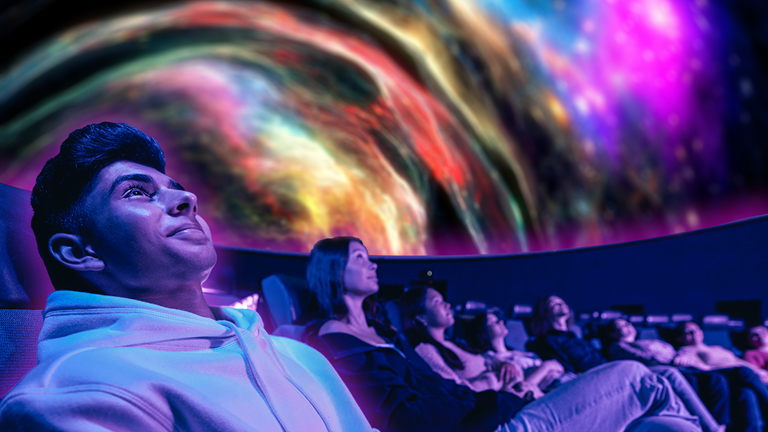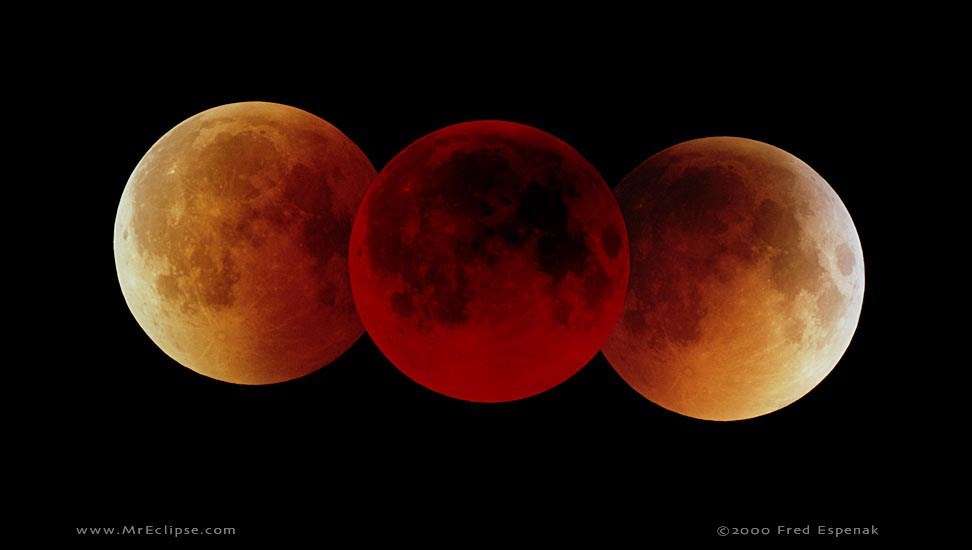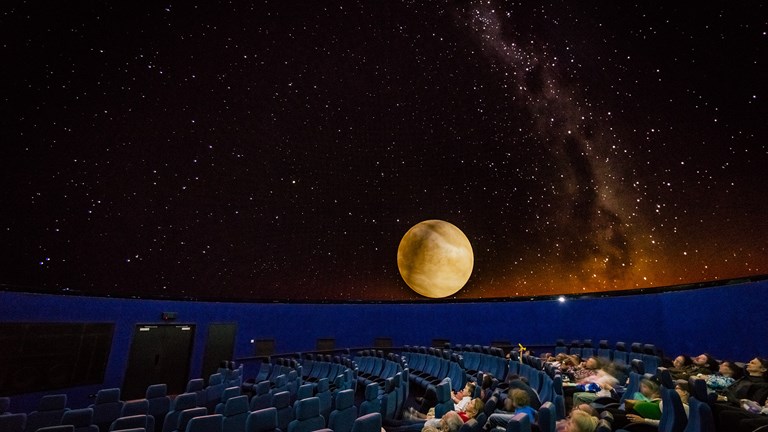
Planetarium Nights
Experience science and art in an evening of immersive cinema for adults 18 years and over.

This month on the night of Wednesday 26 we will have a full ‘super’ moon coinciding with a total lunar eclipse.
The moon’s entire hemisphere as seen from earth will be totally lit by the sun as our lunar companion moves to the side opposite to the sun – a full moon. It will also be closer than usual making it appear a little larger and brighter than the average full moon - a ‘supermoon’. Additionally, for a few hours the moon will also slowly enter the shadow of our planet, then emerge back into full sunlight to complete the night’s full moon – a total lunar eclipse.
Two factors combine to create full moons and ‘supermoons’; the shape and the angle of the moon’s orbit around earth. Firstly, the moon’s 28-day orbit is elliptical. The average earth-moon distance is 384,000 km but that can vary by about 50,000 km from closest (perigee) to furthest (apogee). And secondly, its orbit is tilted a little over 5 degrees in relation to earth’s orbital plane or path around the sun. Together these combine to give us full and sometimes ‘super’ moons as our planet rarely ‘gets in the way’ of sunlight fully illuminating the moon.
The exception, however, is a lunar eclipse when the moon crosses earth’s orbital plane and, over several hours, happens to pass through the narrow cone of earth’s shadow that extends into space well beyond the moon’s orbit. As the moon enters the Earth’s umbra (or full shadow) we see a partial eclipse, with only part of the moon in shadow. But once all of the Moon has crossed into the shadow we experience a total lunar eclipse and a reddened, or copper blood moon, as a small amount of sunlight bends or refracts through our atmosphere losing its blue wavelengths leaving only the red end of the spectrum to faintly bathe the lunar surface.
Enjoy this accurate animation of May’s Lunar Eclipse from timeanddate.com.
Melbourne eclipse times on Wednesday 26 May
Partial Eclipse Begins: 7.45pm
Total Eclipse Begins: 9.11pm
Total Eclipse Ends: 9.25pm
Partial Eclipse Ends: 10.52pm
Solar System Tour – family webinar on 26 May with astronomer Dr Tanya Hill joining in with insights on the eclipse visible that night.
Solar System Tours is a special online four-part series with the option to attend a single session. The family series is on Thursdays evenings in May or book ahead for the adult series in June.

Experience science and art in an evening of immersive cinema for adults 18 years and over.

The sky indoors - shows run every day under the dome exploring space, astronomy and the night sky.
| Date | Rise / Solar noon* / Set (day length) |
|---|---|
| Sat 1st | 7.01am / 12.17pm / 5.33pm (10.32 hrs) |
| Tue 11th | 7.09am / 12.16pm / 5.22pm (10.12 hrs) |
| Fri 21st | 7.18am / 12.16pm / 5.14pm (9.56 hrs) |
| Mon 31st | 7.25am / 12.17pm / 5.09pm (9.43 hrs) |
*When the Sun is at its highest crossing the meridian or local longitude.
| Phase | Date |
|---|---|
| Third Quarter | Tue 4th |
| New Moon | Wed 12th |
| First Quarter | Thu 20th |
| Full Moon | Wed 26th |
This month’s Moon perigee (closest to Earth) is on Wed 26th at 357,311 km and apogee (furthest from Earth) is on Wed 12th at 406,512 km.
Mercury, rises late morning and sets by 7.30pm but is too close to the horizon to be seen in Melbourne this month.
Venus is also not visible from Melbourne this month as it rises in the morning daytime, stays very low to the horizon, and sets by 6pm.
Mars rises late morning and by evening will continue to be visible low in the north-west before setting about three hours after sunset.
Jupiter rises in the east shortly after midnight and will be bright in the north-west before fading from view in the morning twilight.
Saturn is ahead of Jupiter rising around 11pm and this yellow-tinged gas giant can be seen in the north-west until, like its larger sibling, is lost in the early dawn light.
The Eta Aquarids meteor shower begins on the 3rd peaking on the 6th. The shower is linked to Comet Halley and rates can reach 55 meteors per hour. They are sand or rice grain size, very fast at 64km/sec, usually yellow with persistent trains, and enter the atmosphere 100km above the surface. They appear in the constellation Aquarius, and the radiant, or point from which they appear to originate, rises at 2.30am moving higher to the north-east by dawn.
The brightest star in the night sky, Sirius, is high in the west and forms the principal star in Canis Major (Greater Dog), a companion to Orion, the hunter who lies below closer to the western horizon with a very obvious red giant star, Betelguese marking one of his two shoulders. The three bright stars that form a vertical line in the centre of Orion are his belt and they and point up to Sirius. If you lean your head onto your left shoulder you can picture them as the base of the ‘Saucepan’ asterism with Orion’s sword or scabbard that lead off his belt forming the handle of the pan. In the centre of the handle or sword/scabbard is a fuzzy greenish object which binoculars or modest telescope will reveal as the glorious Orion Nebula – a vast cloud of gas and dust where young stars are forming.
In the Boorong tradition of north-west Victoria Sirius is also the head of Warepil the wedge-tailed eagle, the largest bird of prey in Australia and one of the most important figures in the night sky, with wings spread out either side to less bright stars.
Above and to the south of Sirius is Canopus, the second brightest star in the night sky which belongs to the constellation Carina (the keel).
In the north is the constellation of Leo, the lion. Leo is upside down compared to the northern hemisphere. Look for an upside-down question mark as his head and mane. The brightest star in Leo is Regulus, meaning ‘little king’.
The large and impressive constellation of Scorpius can now be seen rising horizontally in the east with its head and pincers reaching east and the long curving tail stretching to the south. The scorpion's heart is marked by the red star Antares. This is a very rich area of the Milky Way and the scorpion's tail contains beautiful star clusters that can be seen with binoculars.
The two bright Pointers (Alpha and Beta Centauri in the constellation of Centaurus) are low in the south-east and lead your eye up to the smallest constellation astronomers use – Crux (or Southern Cross) which sits on its side this month and easily recognisable. In Boorong lore this is Bunya, the possum who was a warrior determined to scare off a giant and dangerous emu. His courage failed him and he fled high into a tree – a wonderful story encompassing human values, animal behaviour and the natural world.
In less light-polluted skies you can see the pale band of light that arc across the entire sky, the Milky Way, billions of distant stars of our galaxy. The dark regions along the Milky Way in the south-east form the emu’s body and the Coal Sack beside Crux is its head.
Out on their own in the south-west lie the intriguing Large and Small Clouds of Magellan, two small nearby galaxies with names derived from Fernão de Magalhães (better known from Spanish as Ferdinand Magellan), the famous Portuguese explorer of the 16th century who attempted the first circumnavigation of the globe. In Boorong stories they are the bodies of two brolgas, wetland birds that are flying in the sky, and in others their eggs ready to hatch, or the campfires of the ancient ones who created the land.
ISS orbits every 90 minutes at an average distance of 400 km appearing like a bright star moving slowly across the night sky. Here are some of the brightest passes expected this month over Melbourne and Central Victoria:
Friday 7th 6.43pm–6.47pm South-West to East
Monday 10th 5.57pm-6.04pm South-West to North-East
Saturday 22nd 6.46am–6.53am North-West to South-East
Sunday 23rd 6.00am–6.06am North-West to South-East
For predictions go to:
1st 1930, Pluto’s name is confirmed by Lowell Observatory after a suggestion by British 11-year old Venetia Burney.
1st 1910, birth of astrophysicist J Allen Hynek who later investigates reports of unidentified flying objects for the US Air Force under ‘Project Blue Book’.
4th 1675, Royal Greenwich Observatory is established by decree of King Charles II.
5th 1961, Alan Shepard Jr (Mercury 3) becomes the first American launched into space in a short sub-orbital flight.
9th 1979, Pioneer Venus 2 (USA) craft sends five probes into the atmosphere of Venus.
11th 1916, Albert Einstein’s ‘General Theory of Relativity’ is first presented.
12th 1965, Luna 5 (USSR) crashes on Moon.
13th 1861, one of eight 19th century ‘Great Comets’ is discovered by John Tebbut.
14th 1973, Skylab 1, USA’s first space station is launched.
15th 1618, Johannes Kepler establishes the Third Law of Planetary Motion by determining a direct relationship between a planet’s distance from Sun and its orbital period.
16th 2011, Space Shuttle Endeavour (USA) is launched on its 25th and final mission.
17th 1969, Venera 6 (‘Venus’ 6, USSR) sends data for 51min before failure due to extreme pressure while descending by parachute to the surface of Venus.
18th 1991, Helen Sharman, the first Briton in space, blasts off onboard a Soyuz spacecraft.
18th 1969, Apollo 10 (USA), the fourth crewed Apollo, is launched on an eight-day full rehearsal mission without a moon landing. It sends the first colour TV to Earth and orbits the moon 31 times. With Command Module ‘Charlie Brown’ in orbit, Lunar Module ‘Snoopy’ flies for two hours in four orbits coming to14km of the surface after which its descent (lower) stage is jettisoned to eventually crash on the moon, and later its ascent (upper) stage is sent into space to orbit the sun.
18th 2005, Pluto’s moons Nix and Hydra are seen by Hubble Telescope before New Horizons’ (USA) later discovery of two more, Styx and Kerberos.
19th 1961, Venera 1 (‘Venus’ 1, USSR) makes first pass of a planet (in this case Venus) although contact with Earth was by then lost.
20th 1990, Hubble Space Telescope sends its first photograph from space, an image of a double star 1,260 light years away.
21st 2010, IKAROS spacecraft (Japan) is launched and employs the first successful solar sail technique for planetary travel.
25th 1961, President John F. Kennedy institutes the USA’s 10-year race to the Moon.
25th 240 BCE, first recorded close pass by the Sun (perihelion) of Comet Halley.
28th 1959, monkeys Abel and Baker are sent on sub-orbital flight of 580 km into space in the nose-cone of a Jupiter rocket.
28th 585 BCE, solar eclipse occurs during a battle between Medes and Lydians; an example of how the knowledge of past eclipses enables dating of historical events.
28th 2002, water ice on the Red Planet is discovered by Mars Odyssey (USA).
29th 1919, Einstein’s ‘General Theory of Relativity’ is confirmed by Arthur Eddington’s study of distant star light bending during a total solar eclipse.
29th 1794, birth of the first astronomer to map the Moon and Mars, Johann von Mädler.
30th 1975, European Space Agency (ESA) is created by merging Launch Development and Space Research organisations.
Museums Victoria acknowledges the Wurundjeri Woi Wurrung and Boon Wurrung Bunurong peoples of the eastern Kulin Nations where we work, and First Peoples across Victoria and Australia.
First Peoples are advised that this site may contain voices, images, and names of people now passed and content of cultural significance.